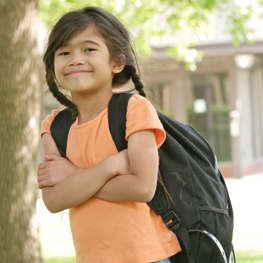
Returning to school can be a pain. While waking up early and doing homework may be unpleasant, perhaps the biggest pain kids will face come September will be felt in their backs.
Loaded with textbooks, supplies and electronics, Canadian kids’ backpacks are now so heavy, Calgary chiropractor Dr. Michael Schmolke says he’s seen an increase in younger patients suffering from backpack-related injuries during the school year.
“Neck strains, shoulder strains, low back strains and headaches [are common injuries we see in kids] from September through June,” says Schmolke, who attributes many of these issues to improper wear of backpacks.
Try these tips on for size when gearing up your child for back to school:
Determine the right fit - Not all backpacks can be treated the same. Schmolke recommends shopping for a backpack with two adjustable padded shoulder straps as well as a waist and chest strap. When trying on a backpack, place the pack on a flat surface at waist height and have your child slip on the backpack one shoulder at a time. Adjust the shoulder straps to fit comfortably. A properly fitted backpack will be snug around the arms and armpits, but not too tight. You should be able to slide your hand between the backpack and your child’s back. To determine if the pack is too small or large for your child, look at its position on your child’s back.
“The bottom edge of the pack should line up with the child’s hips and be secured there with a waist strap [and] the top of the pack should not extend above shoulder height,” says Schmolke.
Avoid weighty packs – A child should carry no more than 10 per cent of their body weight in their backpack. Heavily weighted backpacks that offer little support can cause kids to hunch their shoulders and pull their heads down causing neck strain and muscle imbalance that could lead to more serious back problems in the future. An overweight backpack can also be cause for safety concerns.
“A child’s balance will be challenged with too much weight load, increasing the rate of falls and slipping on the stairs of the bus or school,” says Schmolke.
Put it on wheels – Wheeled backpacks can alleviate some of these back concerns, but Schmolke says the pack should still be limited to a weight of no more than 10 per cent of body weight. “If they lift it, or alternate between wearing versus pulling, the weight should still be only 10 per cent,” he says. Rolling backpacks are great when strolling through an airport, but they might not be useful in the schoolyard. Their rigid frames can be uncomfortable if the child has to wear the pack, especially in the winter or on grass when wheels may not roll as easily.
Avoid the off-the-shoulder look – While slinging backpacks off one shoulder may look cool, and several sling packs are on the market to cater to that look, Schmolke says these packs aren’t meant to carry any significant weight.
“They’re handy and trendy, but with only one strap, sling backpacks burden the shoulder that the strap rests on,” says Schmolke.
Carried on one shoulder, a heavy pack forces the back muscles and spine to compensate for the uneven weight, placing stress on the mid and lower back and may increase the likelihood of developing back problems later in life.
Pack it properly – Children’s packs should only contain what is needed for the day. Clean out backpacks each night to remove items that aren’t absolutely required. When packing, place heavy objects closest to the body and bumpy or odd-shaped items on the outside so they don’t dig into the child’s back.
Lisa is a health and fitness freelance writer.
Calgary’s Child Magazine © 2024 Calgary’s Child